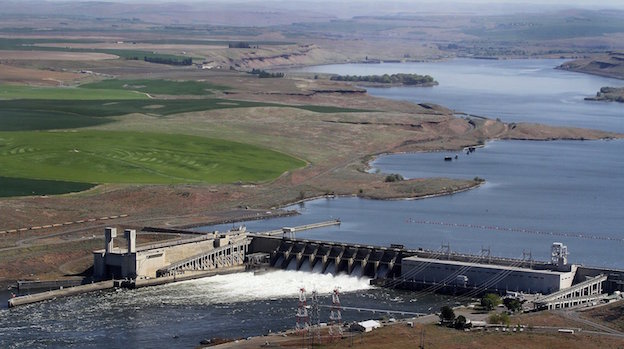forum
library
tutorial
contact

States Need Federal Cooperation
to Save Salmon
by Eric Crawford
Spokesman-Review, December 23, 2020
|
the film forum library tutorial contact |

|
States Need Federal Cooperation
by Eric Crawford
|
The solution with the greatest positive impact on salmon is removal of
the earthen portion of four dams on the lower Snake River.
 You'd be forgiven if you thought these days that the public discourse has become something of a shouting match -- that volume is prized more than good sense and hollering over each other is more important than talking with each other.
You'd be forgiven if you thought these days that the public discourse has become something of a shouting match -- that volume is prized more than good sense and hollering over each other is more important than talking with each other.
But here's a surprising place that it isn't happening, in discussions about how the region plans to bring salmon and steelhead back to abundance.
If you followed this debate 30 or even 10 years ago, you might not recognize it today.
At public meetings held by Gov. Jay Inslee's office earlier this year -- in Eastern, central, and southwestern Washington -- people made clear that you can't restore salmon without accounting for our region's other needs, like agriculture and energy.
Utilities from across the region and conservation groups laid out goals they all agree on, including abundant and harvestable salmon.
And the Columbia Basin Partnership, a diverse group of stakeholders and governments, has established abundant salmon as a key goal.
Now Gov. Inslee, Idaho Gov. Brad Little, Oregon Gov. Kate Brown and Montana Gov. Steve Bullock have pledged their four states will collaborate on rebuilding salmon populations in the Northwest. This is good news.
It's critical that state leadership not only work together and across the aisle, but that they bring in other voices, including business and communities from eastern Washington and Idaho.
They should also move quickly to involve the sovereign tribes that rely on Columbia Basin resources. Tribes across the region were promised by treaty access to salmon. Those promises were broken. We have a chance now to begin repairing them.
More voices -- talking with, not past, each other -- mean more ideas, from more perspectives. That's how we ensure our region moves forward as a whole.
As the Army Corps of Engineers noted in its recent Environmental Impact Statement (EIS) on the basin, the solution with the greatest positive impact on salmon is removal of the earthen portion of four dams on the lower Snake River. Other tacks have been tried over the past several decades to recover salmon; none has worked.
It's not just that dams obstruct and kill fish directly, but they also heat water and slow migration, which makes salmon easier prey. all of which are driving salmon to extinction. They also inundate 140 miles of spawning and rearing habitat, which limits reproduction.
Years of plummeting salmon and steelhead numbers are taking huge tolls on family businesses and the outdoor economy. They're devastating tribal operations and culture.
It's an urgent problem, and we need to address it that way.
In that light, this new collaboration by the states is necessary -- but it's not sufficient. The four dams are under the jurisdiction of the federal government. It's up to Congress, then, with regional input from states, Tribes and stakeholders, to craft a solution for salmon and energy in the Northwest.
Federal agencies have not done much to support the region's goal of abundant fish.
While the Corps of Engineers, working on the EIS with the Bureau of Reclamation and Bonneville Power Administration, acknowledged the singular benefits of dam removal for salmon, it did not recommend implementing that strategy.
It pushed instead a status quo approach of spilling more water over the dams. The goal? Merely to avoid salmon extinction (and it may not succeed in clearing that low bar, which is in part why some environmental groups are taking Corps to court).
That's not the proud salmon legacy our region stands on. We know we can do better than this, when we work together.
We're calling on members of Congress from both parties to lead us toward a solution for salmon, energy and communities. Specifically, we need legislation that will remove the four lower Snake River dams, to bring abundant salmon and steelhead back to Washington, Idaho and Oregon in support of communities and Tribes that rely on them.
But it can't only return salmon to abundance. Bipartisan legislation must also provide irrigation and transportation solutions for farming families that have depended on dammed water for their livelihoods. We can't talk dams without talking farms.
Finally, any bill must also ensure that our region has affordable, reliable, clean energy, as we have for the past century. New sources like wind and solar will create regional jobs, keep costs reasonable, and help the Northwest weather the effects of climate change.
Put another way, abundance is what our region should be about: abundant salmon, abundant agriculture, abundant clean energy.
Such a bill -- either standalone or as part of an infrastructure package -- would achieve common goals set forth by utilities and conservation groups earlier this year and create high-paying jobs.
This work is ambitious. It's also achievable when we're working in partnership -- members of Congress, with Governors, with Tribes. Communities, businesses, and families, together.
The noise you hear doesn't have to be people shouting over each other. It could be the sound of people working together, on a solution that works for all.
learn more on topics covered in the film
see the video
read the script
learn the songs
discussion forum
